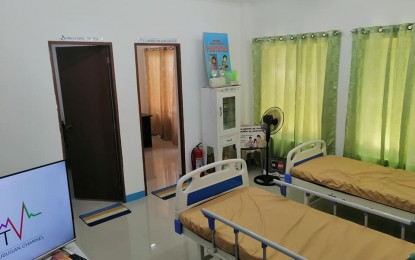
SAFE PLACE. A glimpse inside one of the amenities in the newly inaugurated Maatasnakahoy evacuation center in Batangas province. Two other similar disaster-resilient facilities in Sta. Teresita and Alitagtag towns were turned over to the local government units on March 30, 2022. (Photo courtesy of DHSUD)
MANILA – Families in three towns in Batangas province needing to temporarily relocate due to calamities, like the ongoing Taal Volcano unrest, will now have safe places to go to.
Thanks to newly constructed inauguration centers that President Rodrigo Duterte ordered the Department of Human Settlements and Urban Development (DHSUD) to erect, families in Sta. Teresita, Alitagtag, and Mataasnakahoy will have less worry in case of future disasters.
The President on Monday inspected the Mataasnakahoy facility.
DHSUD Secretary Eduardo del Rosario said the evacuation centers, worth PHP40 million, can each accommodate 150 families or 600 individuals.
“The technical specification of these evacuation centers was based on the design of the National Housing Authority (NHA) and was duly approved by the President himself when I had presented it to the Cabinet way back 2018,” he said in an interview.
Each site has a floor area of 1,451 square meters complete with amenities like an administrative office and reception area, storage room, kitchen and mess hall, play area, health and consultation clinic, prayer room, conference room, breastfeeding area, basketball court, separate female and male comfort rooms, and rooms for couples.
It also has 40 toilets, 22 shower rooms, and nine urinal facilities that are proportionally divided and segregated for men and women.
Around 106 modular tents can also fit each open area.
The three evacuation centers are strategically located on safe grounds beyond the 14-kilometer danger zones -- Barangay Calayaan, Sta. Teresita; Barangay San Juan, Alitagtag; and Barangay Dos, Mataasnakahoy.
“It was funded through the socialized balance housing compliance program funds in order to address the needed gaps for housing settlements and community development,” del Rosario added.
He said the construction projects were part of the government’s response to the Taal Volcano eruption in January 2020.
Del Rosario said the DSHUD is already implementing the land development for resettlement sites in five municipalities intended to accommodate families severely affected by the previous eruption.
The NHA earlier awarded 585 housing units to displaced families.
As of March 31, the National Disaster Risk Reduction and Management Council reported that about 2,047 families or 7,237 individuals residing in 18 Batangas villages are affected by the ongoing unrest.
The volcano has been under Alert Level 3 since March 26.
Taal Volcano Island, a permanent danger zone; and Bilibinwang and Banyaga villages in Agoncillo; Boso-Boso, Gulod, and Bugaan East villages in Laurel, Batangas province are considered high risks due to the possible hazards of pyroclastic density currents and volcanic tsunami should stronger eruptions occur. (PNA)
